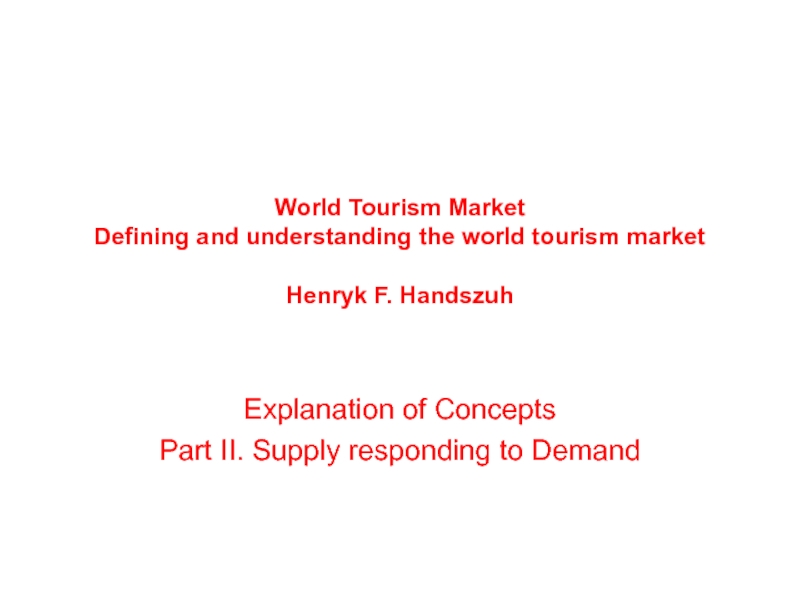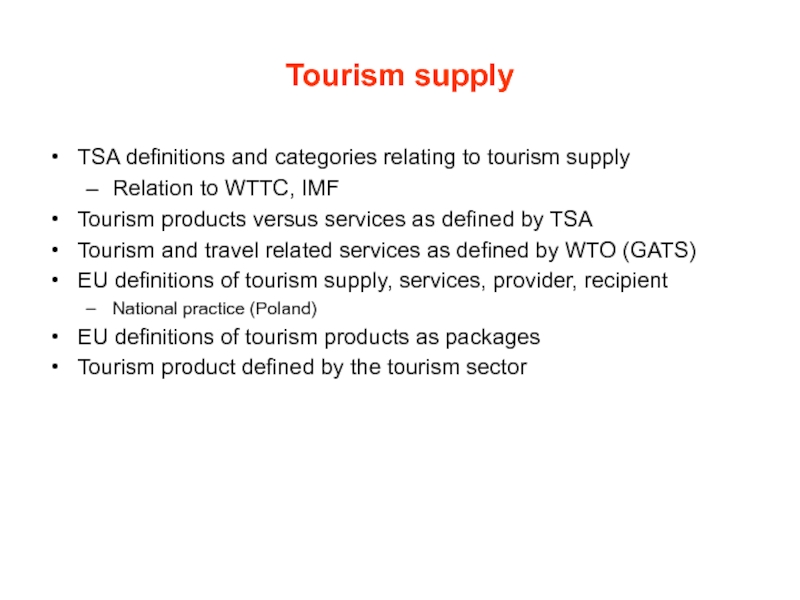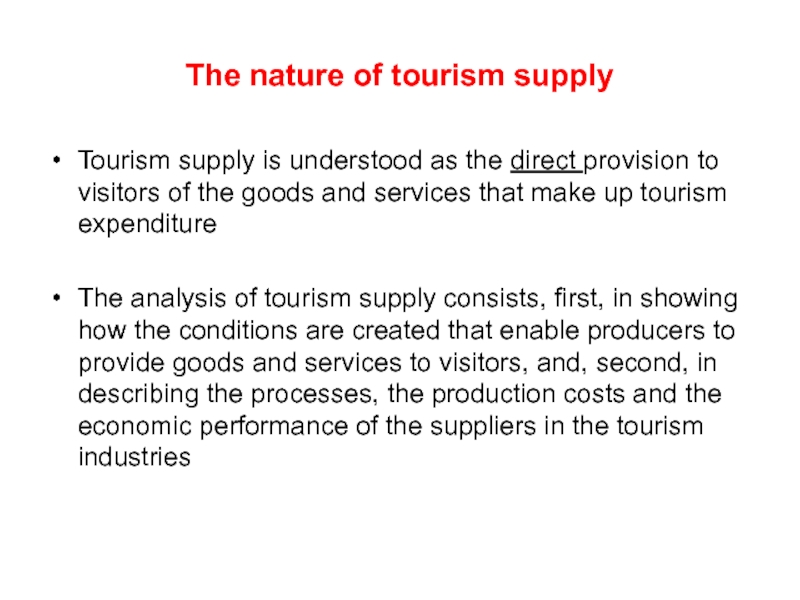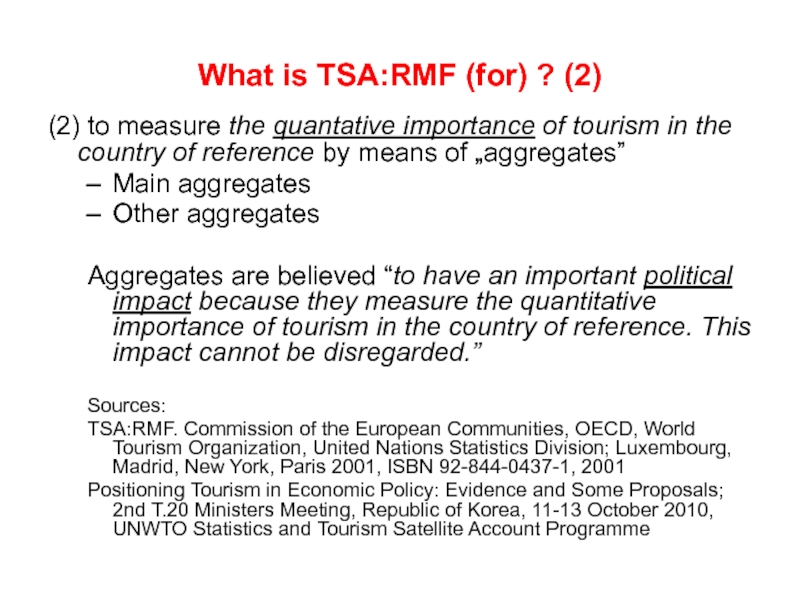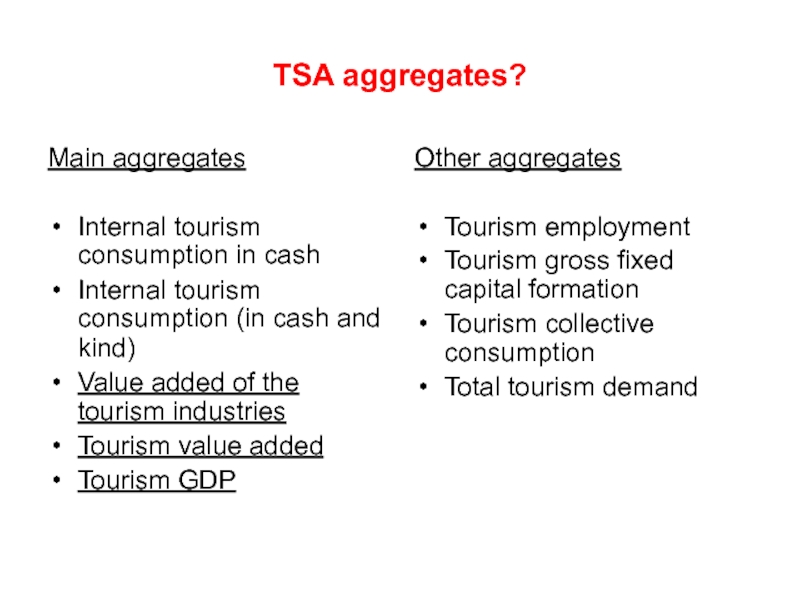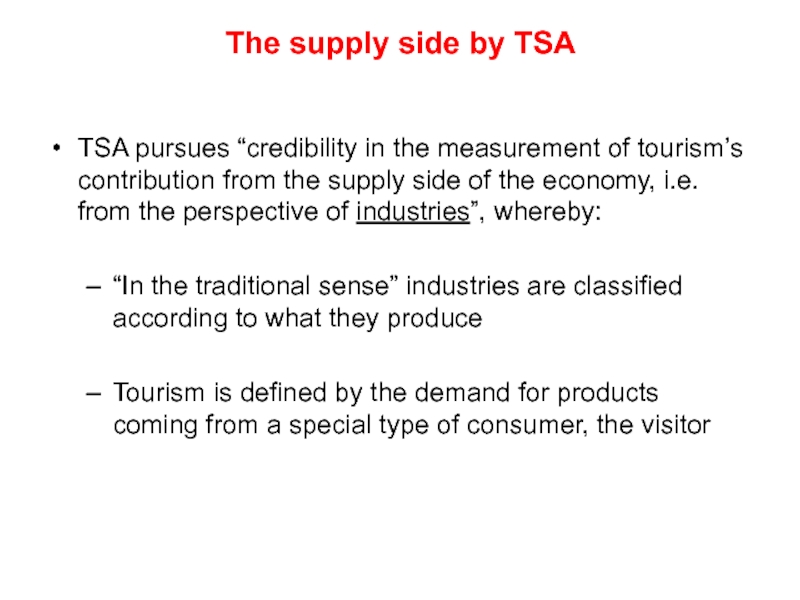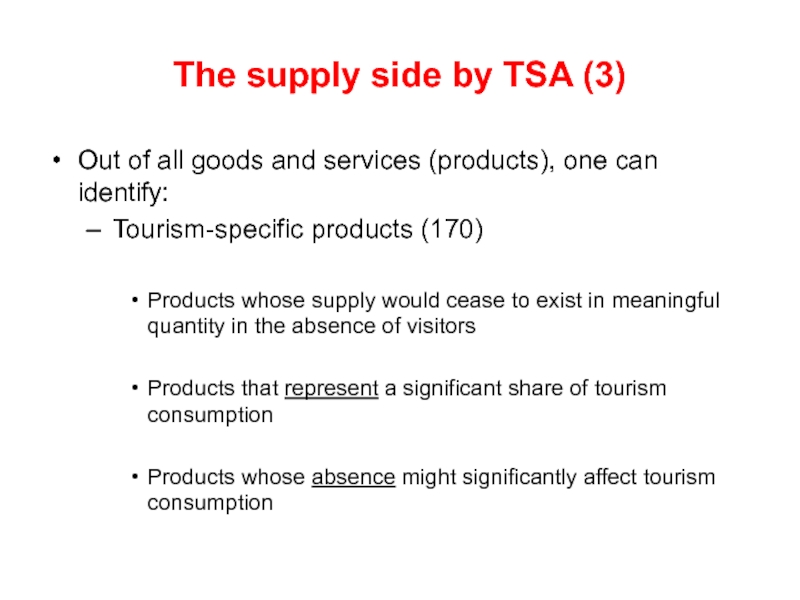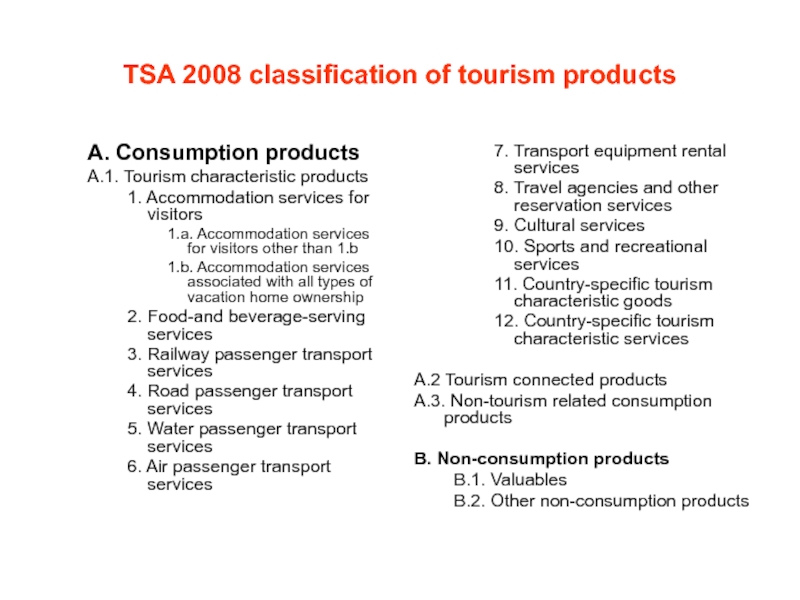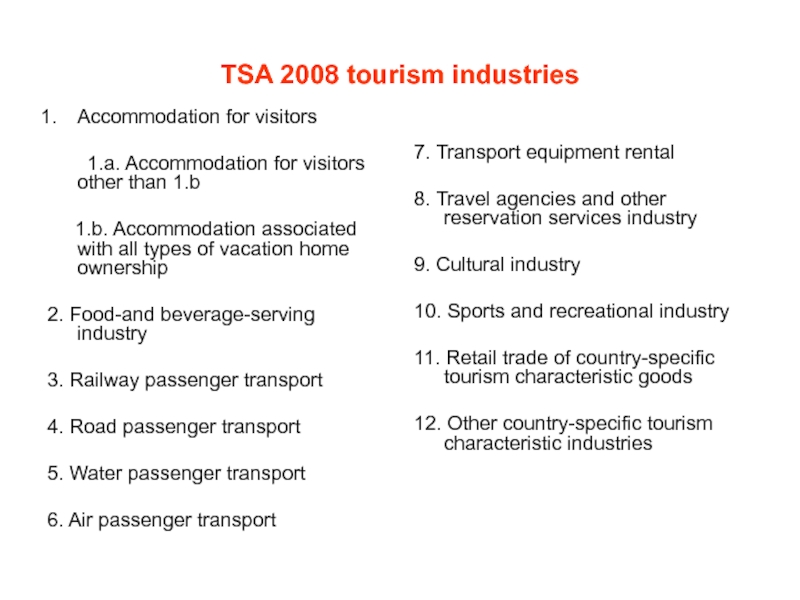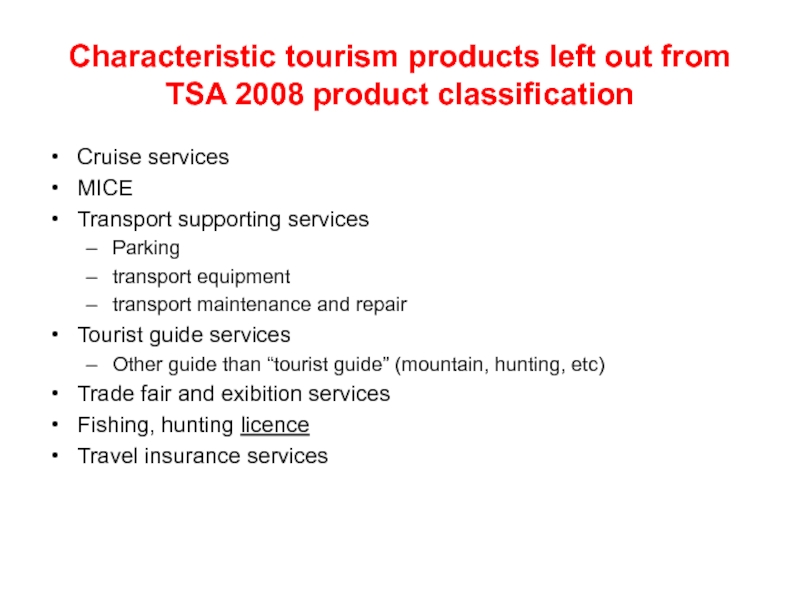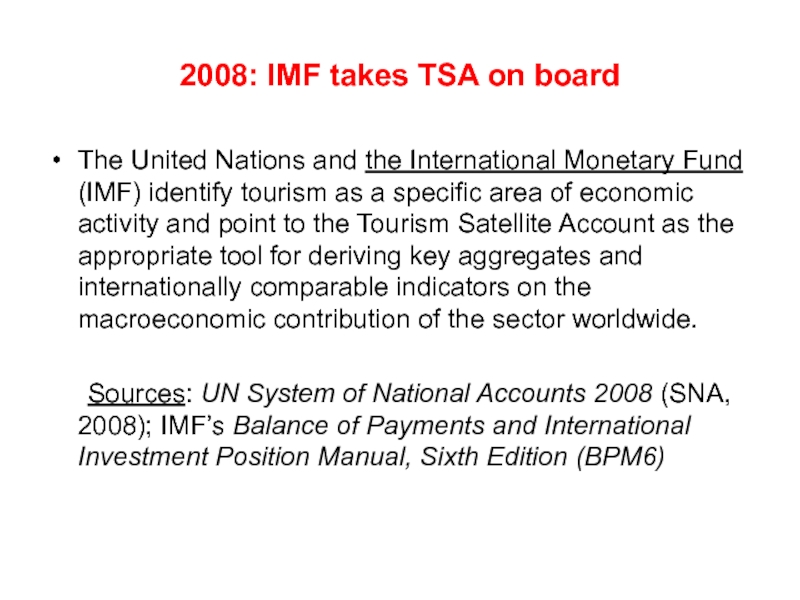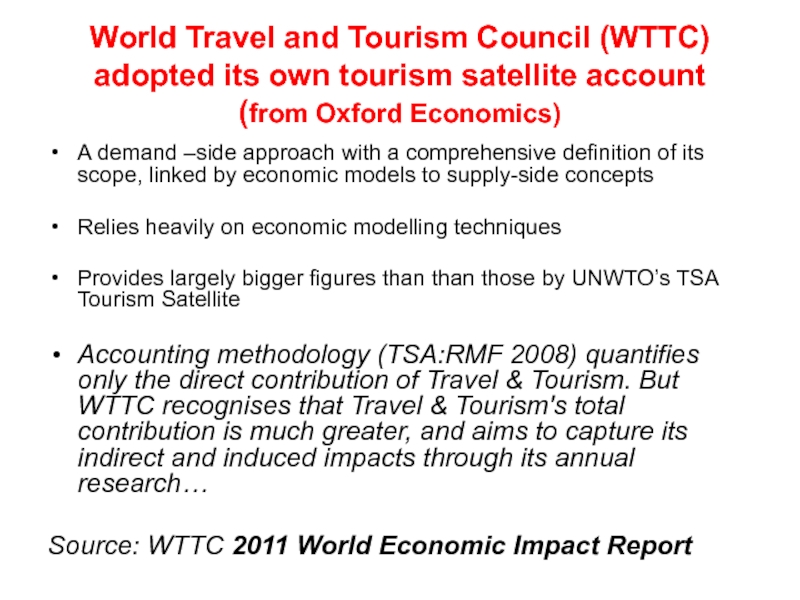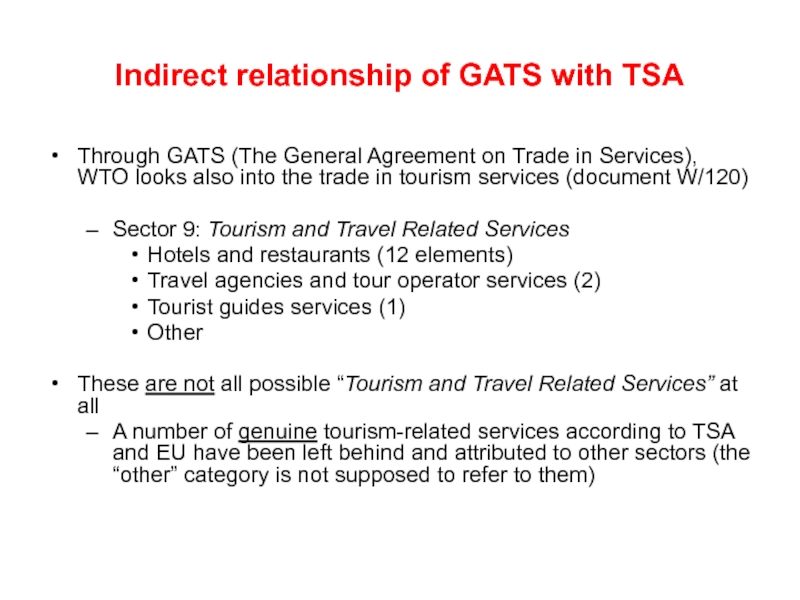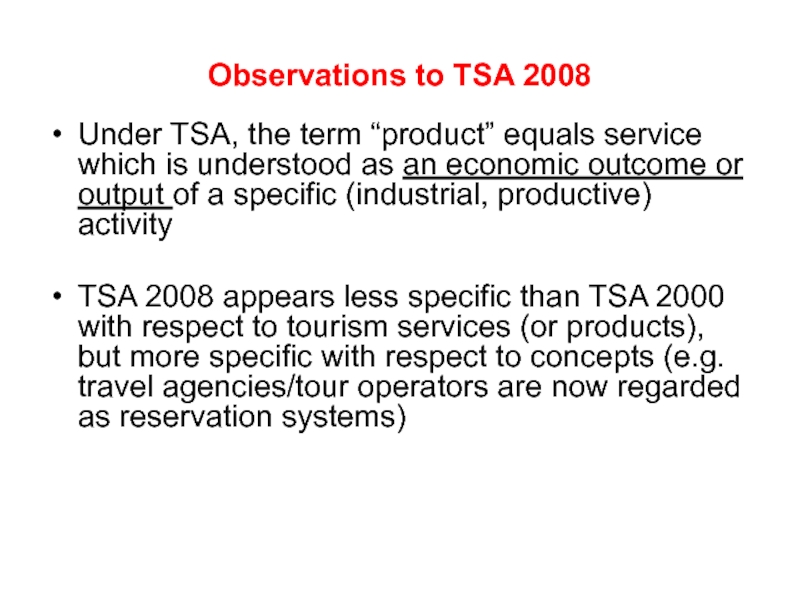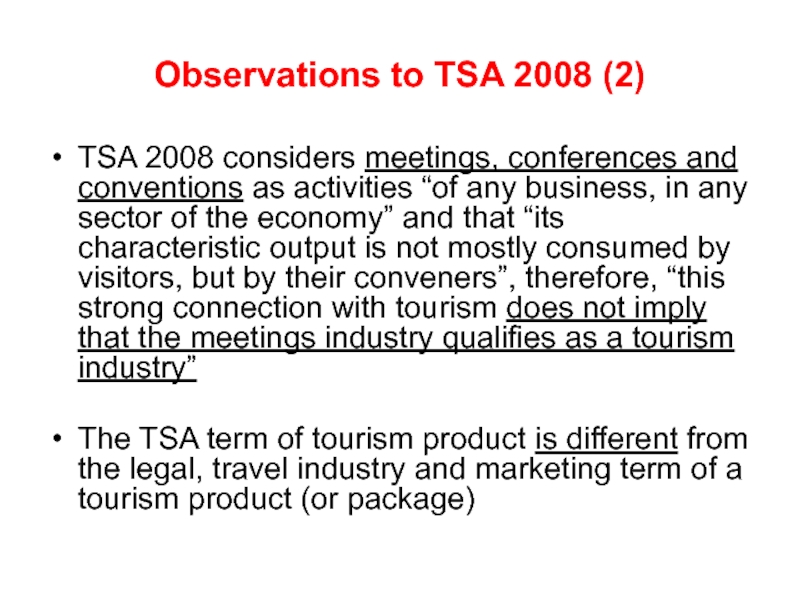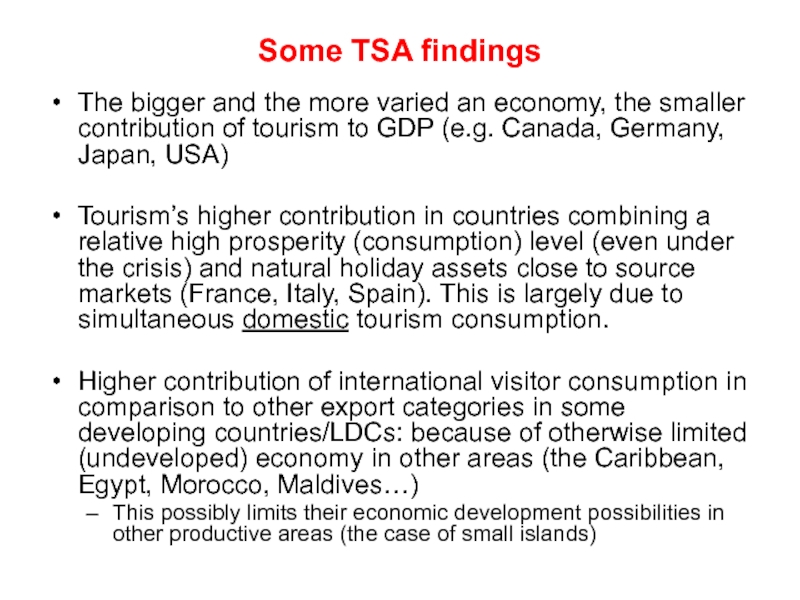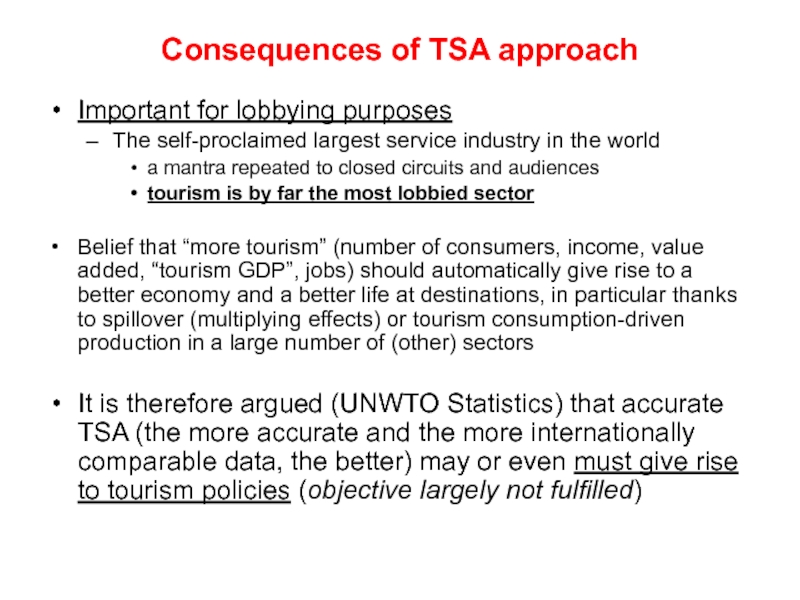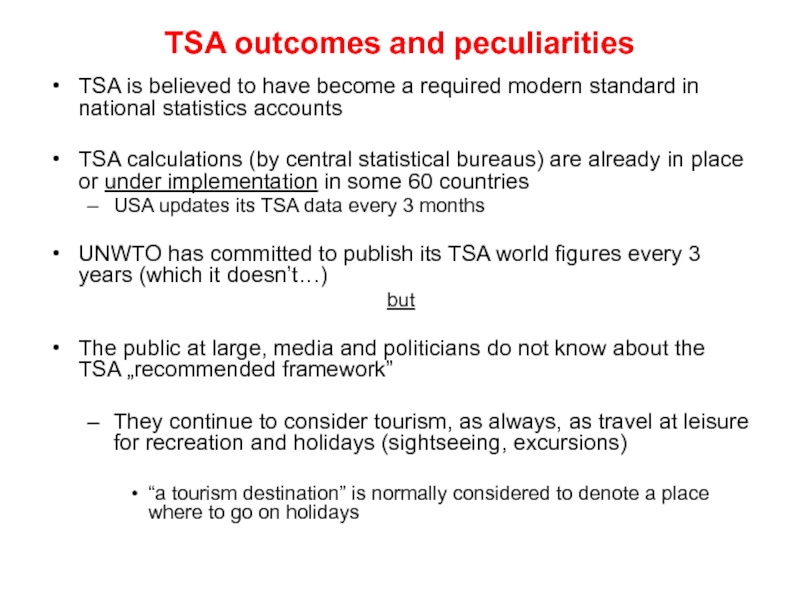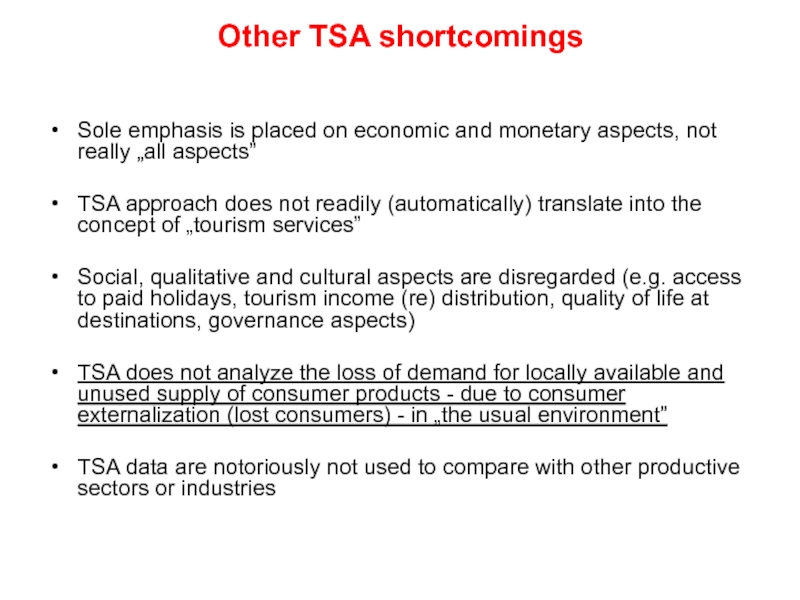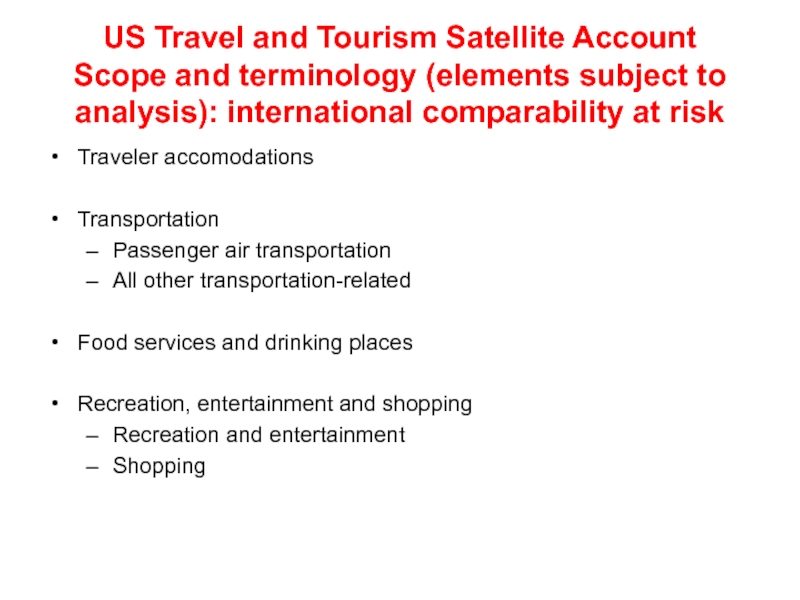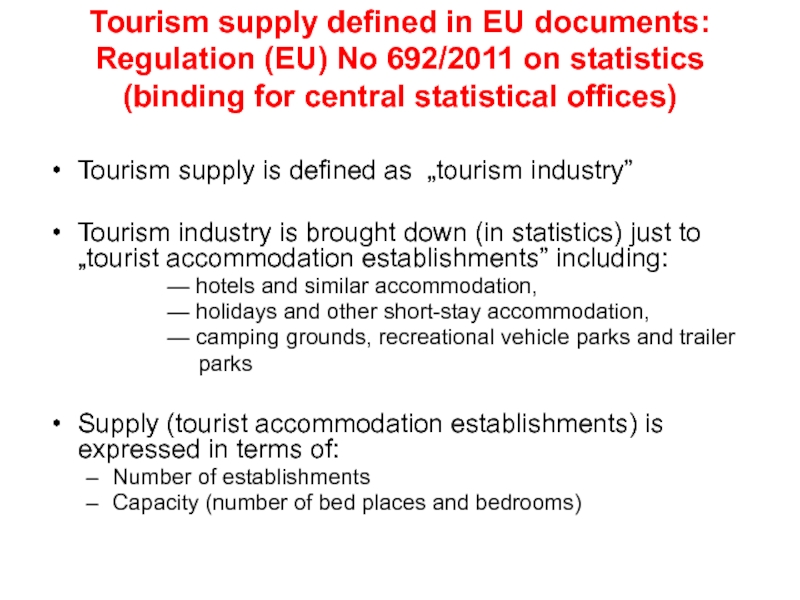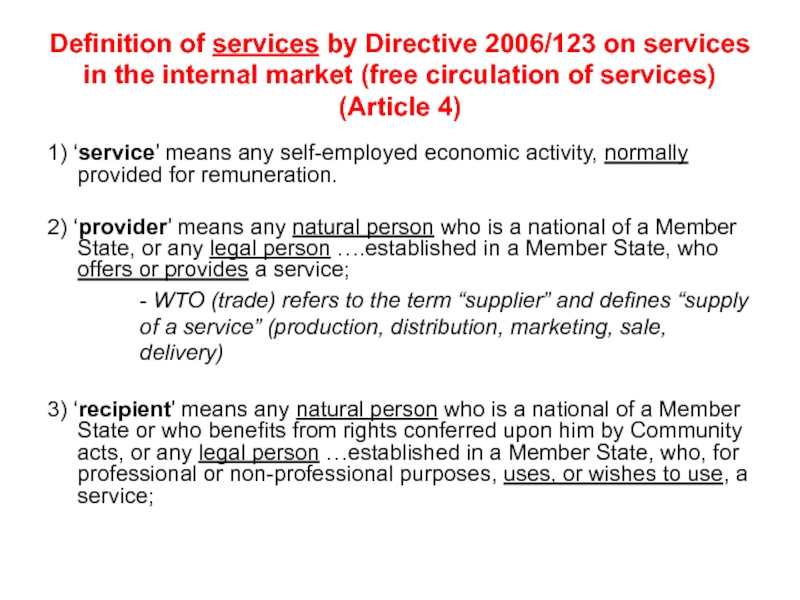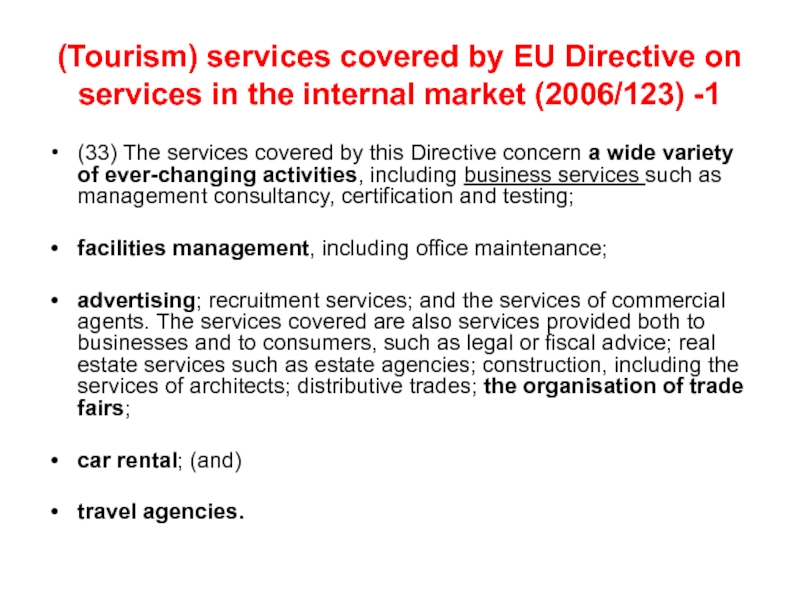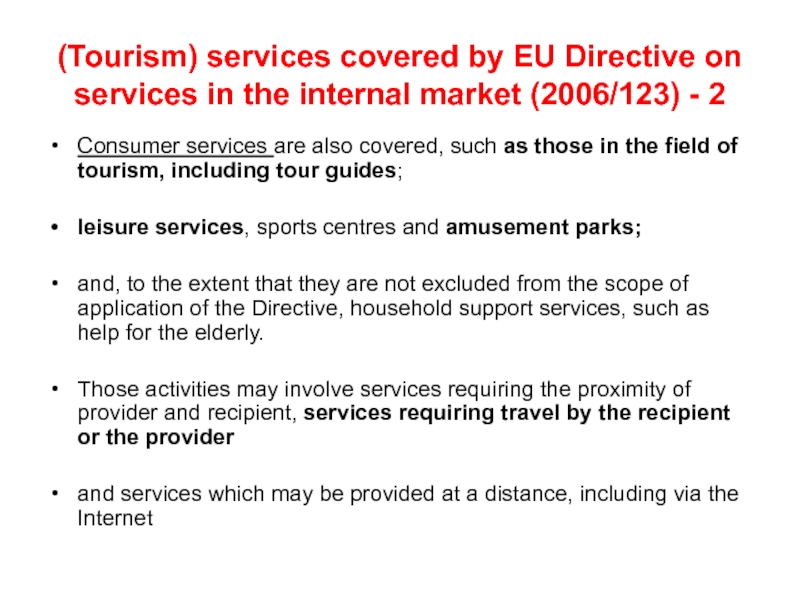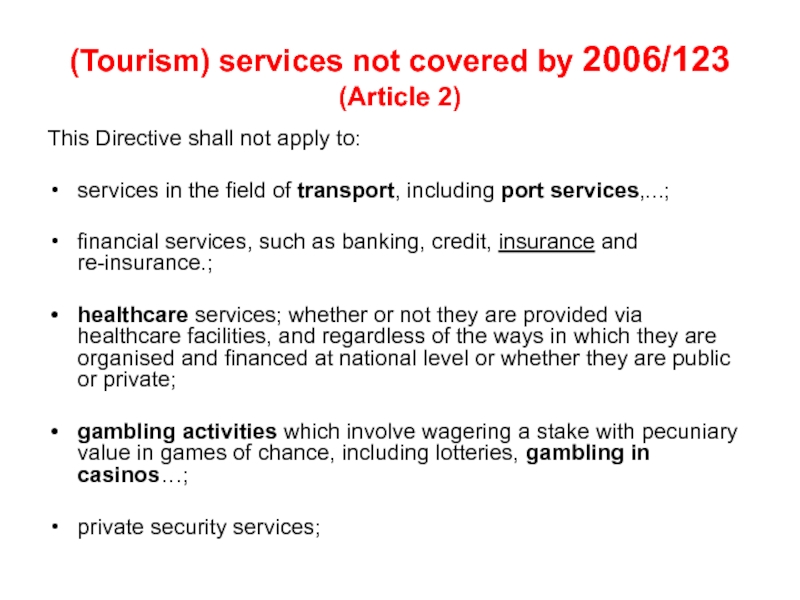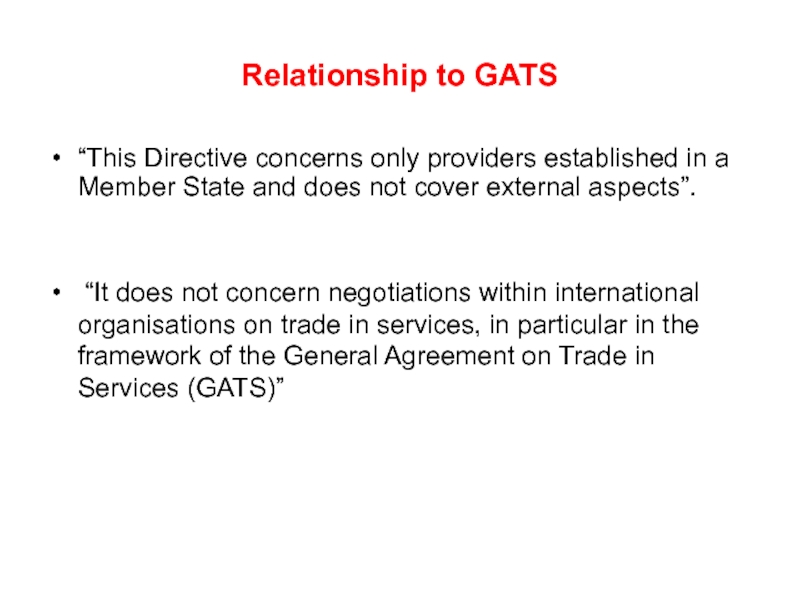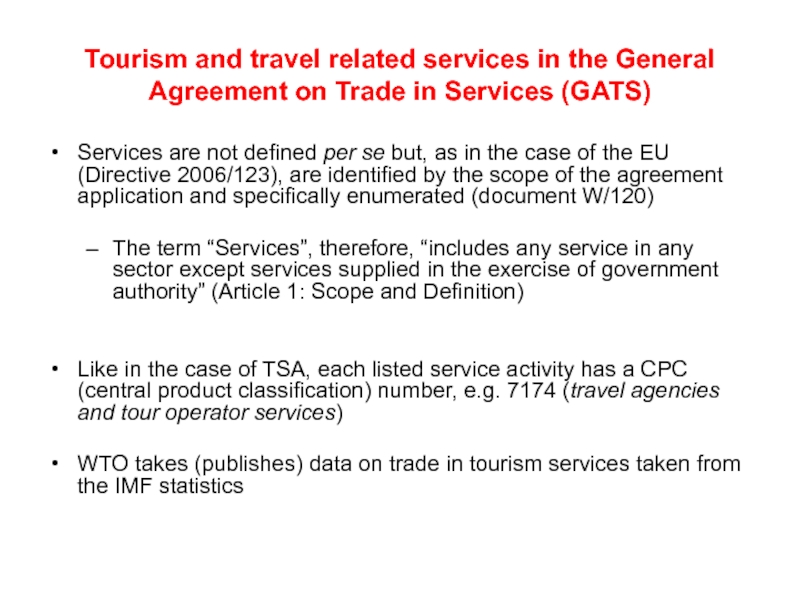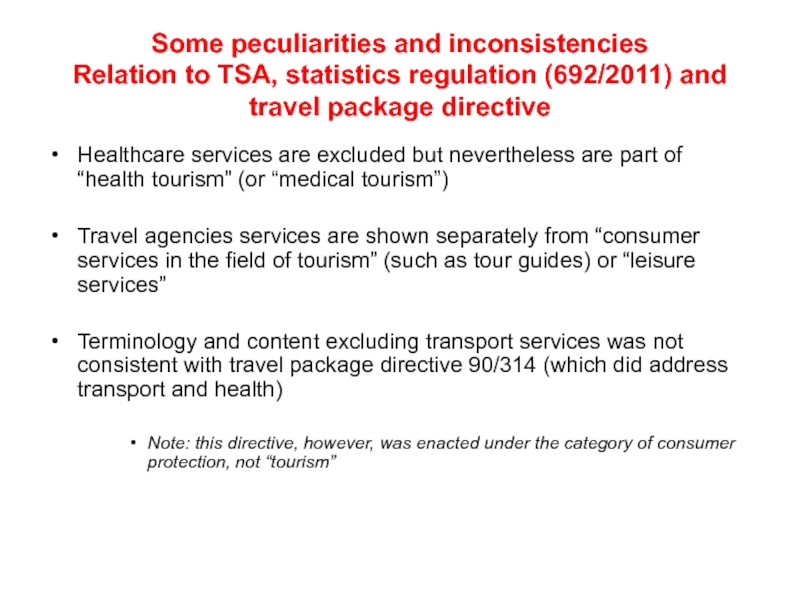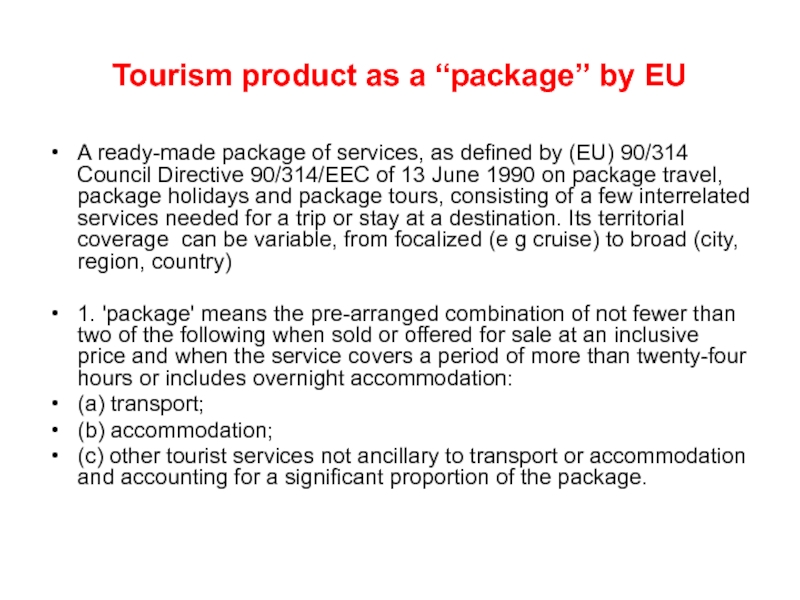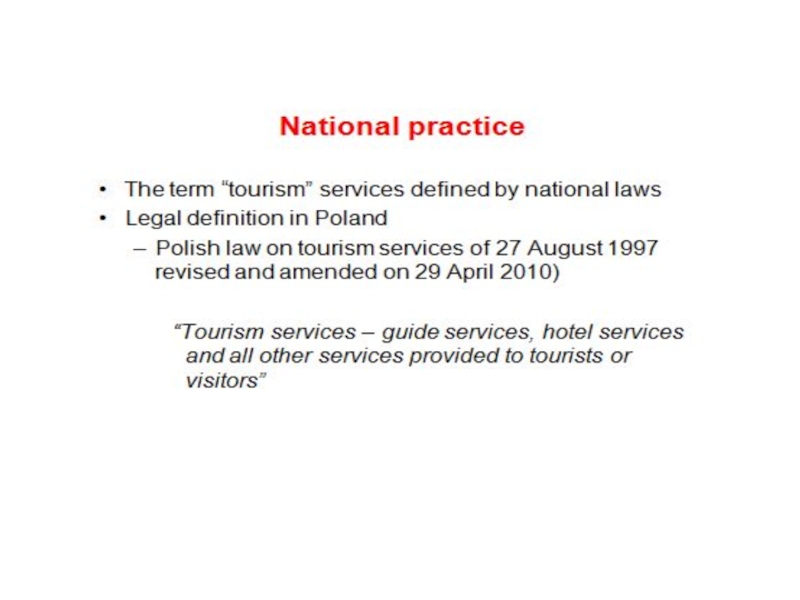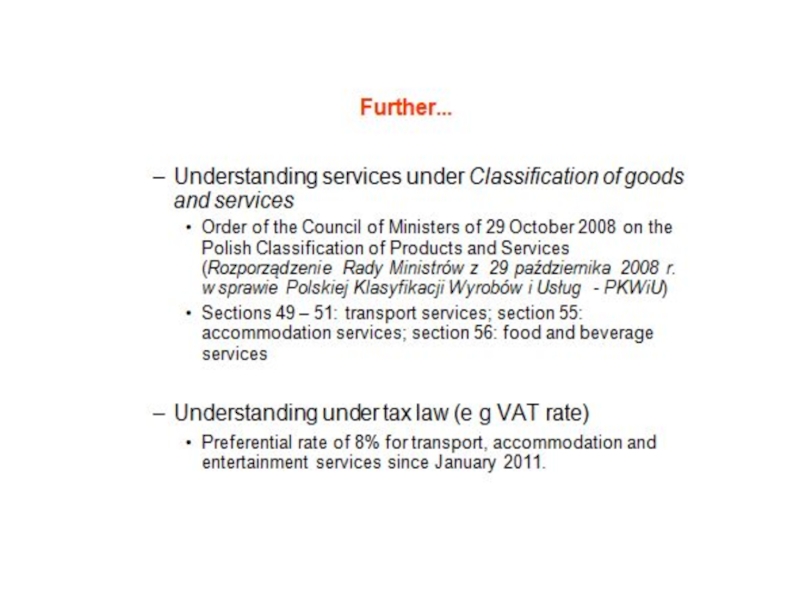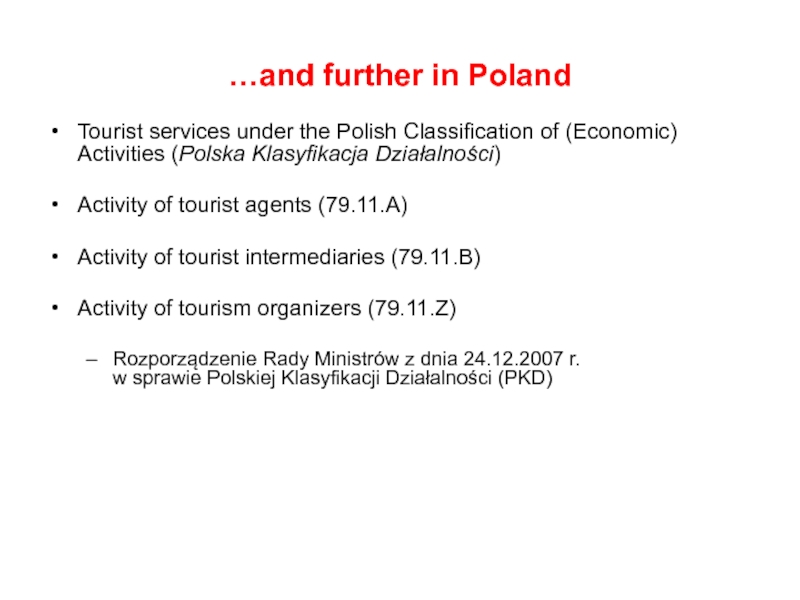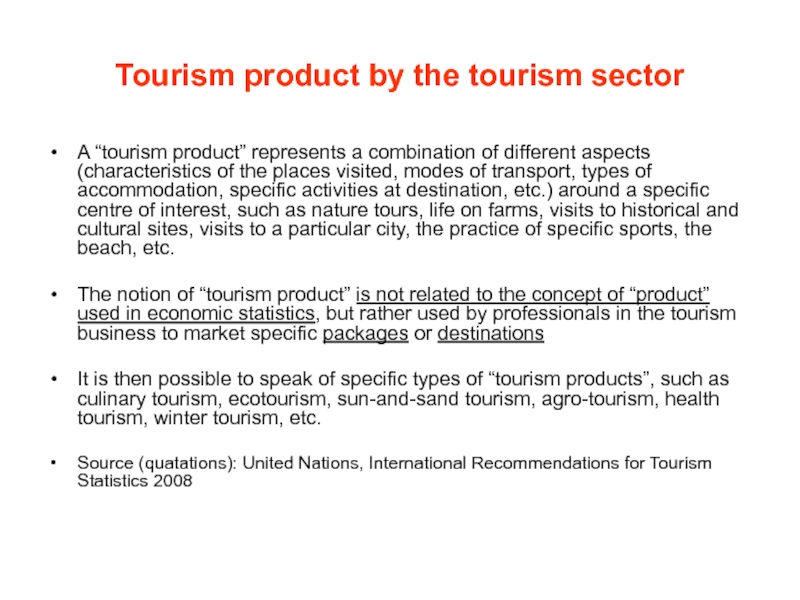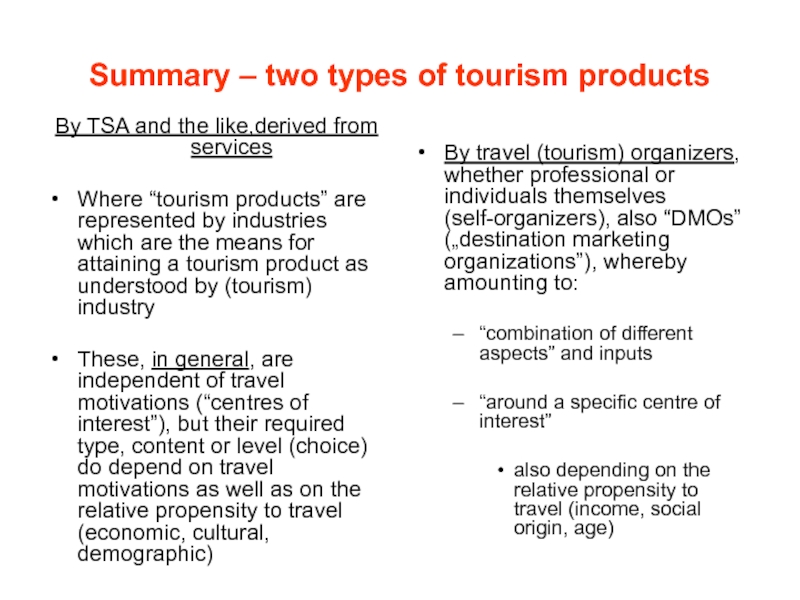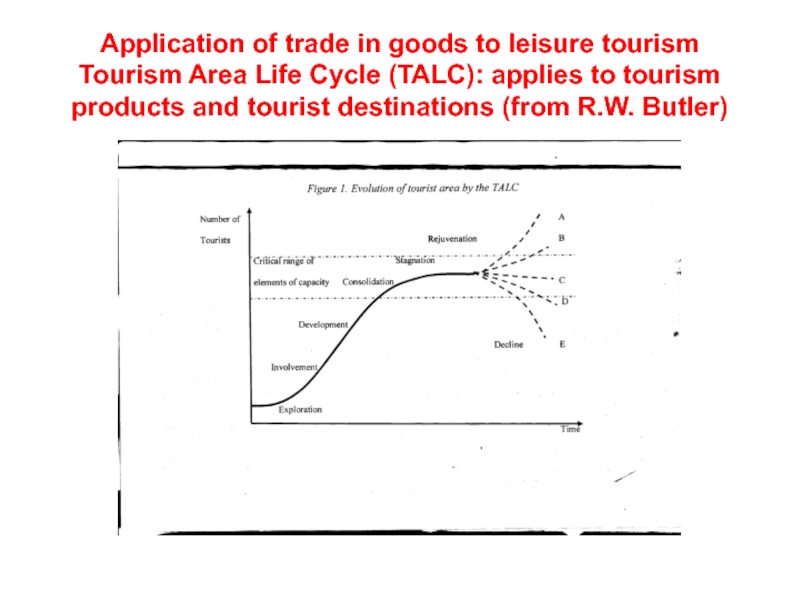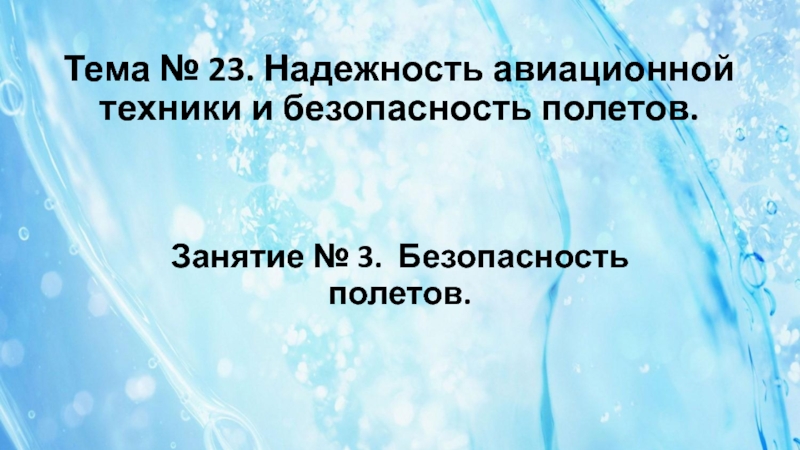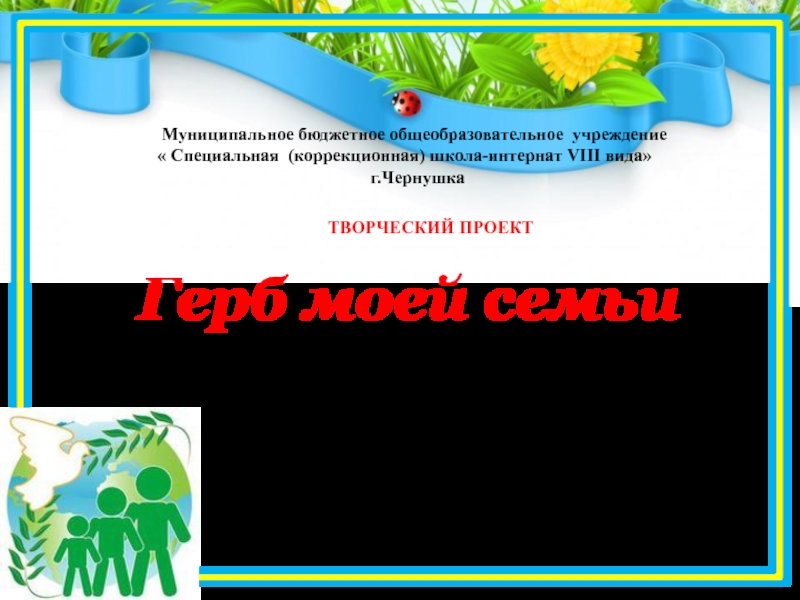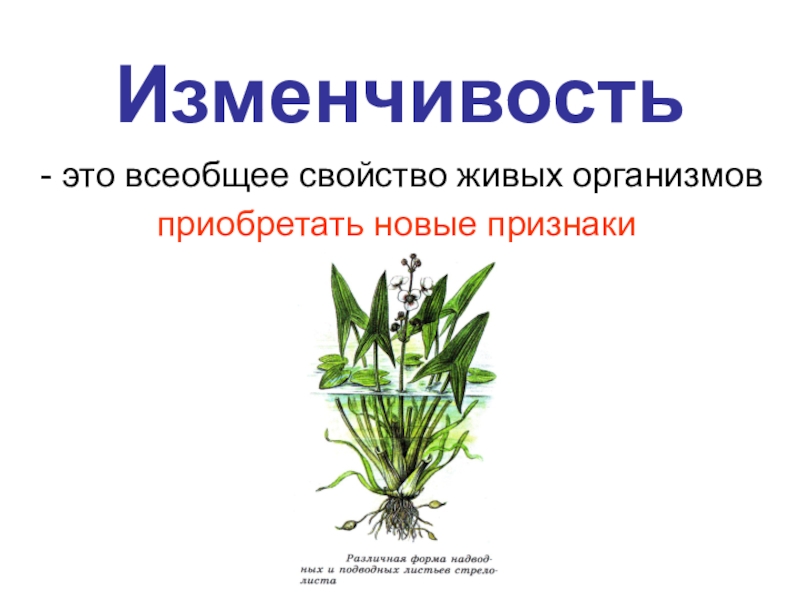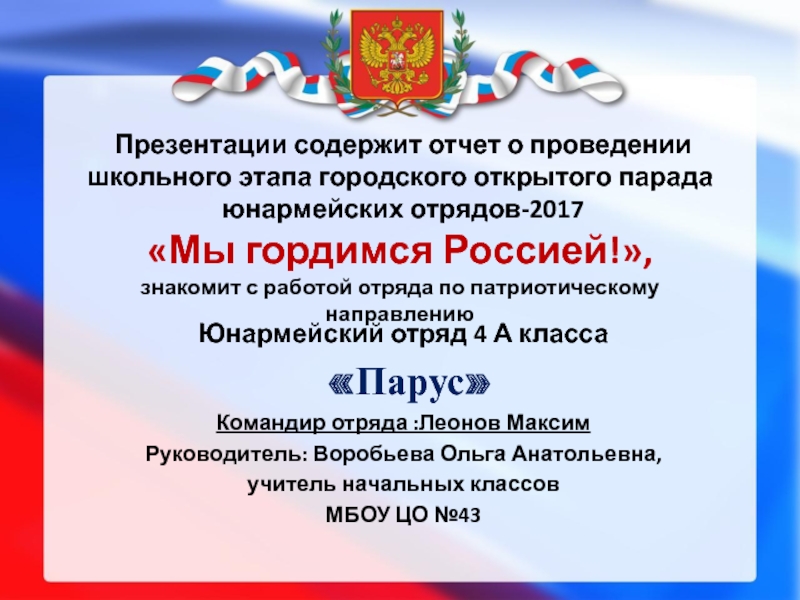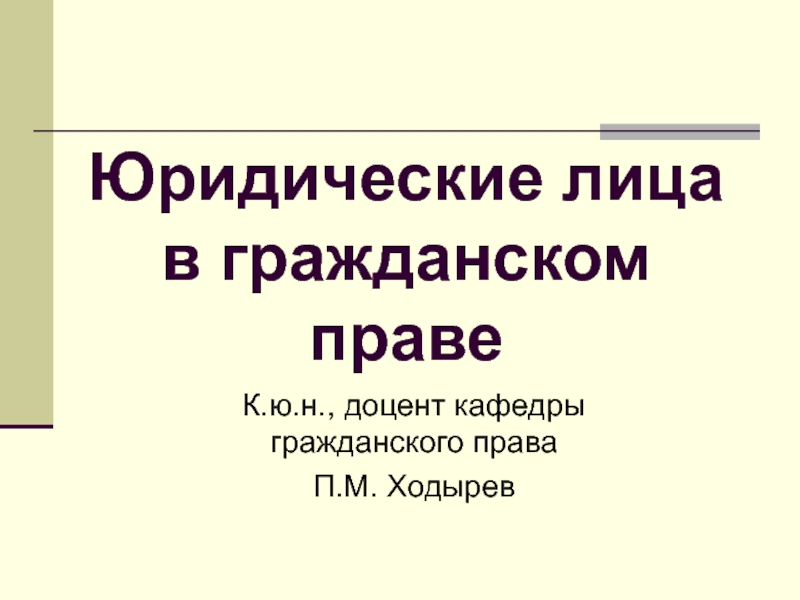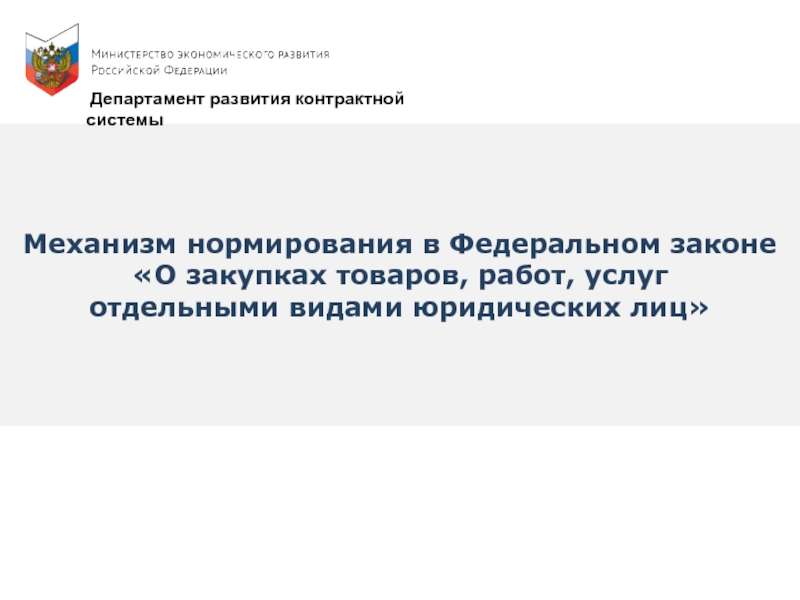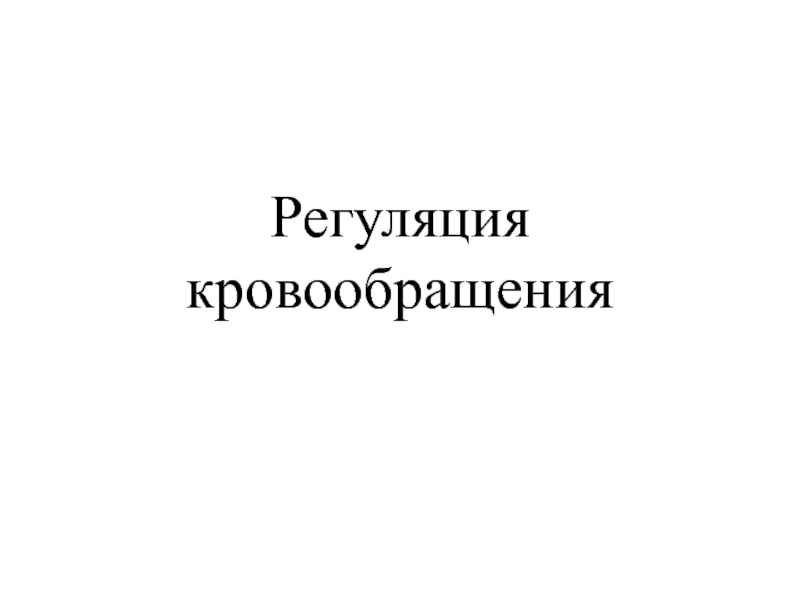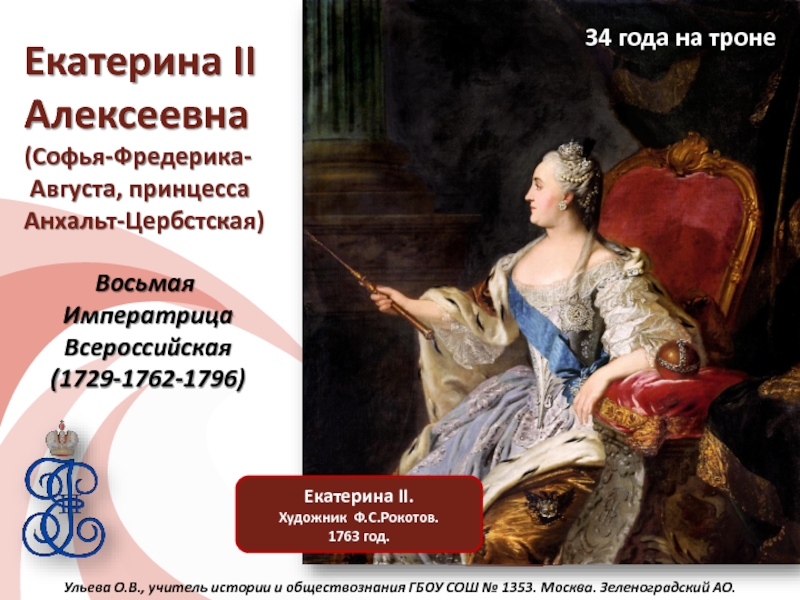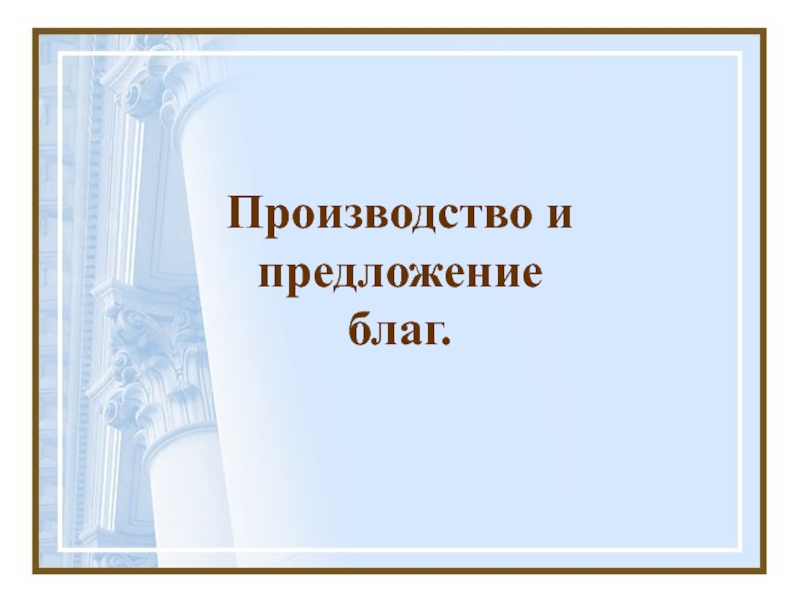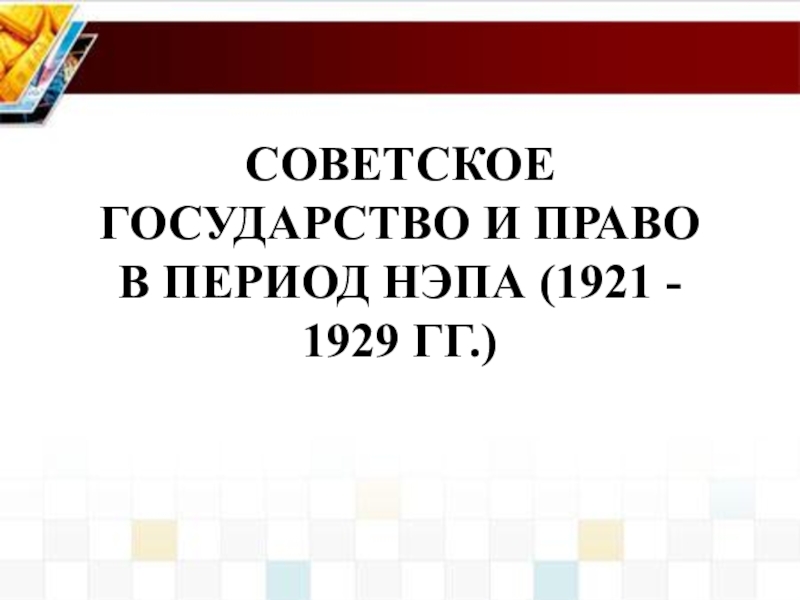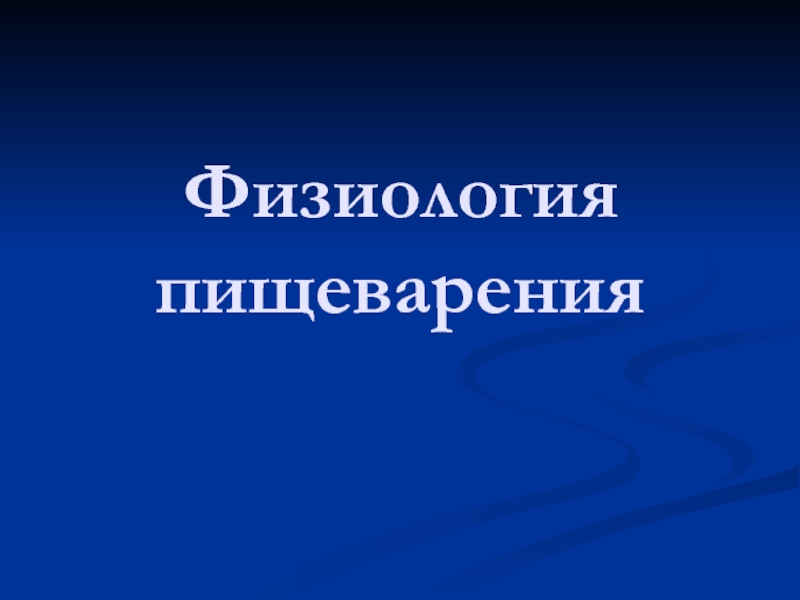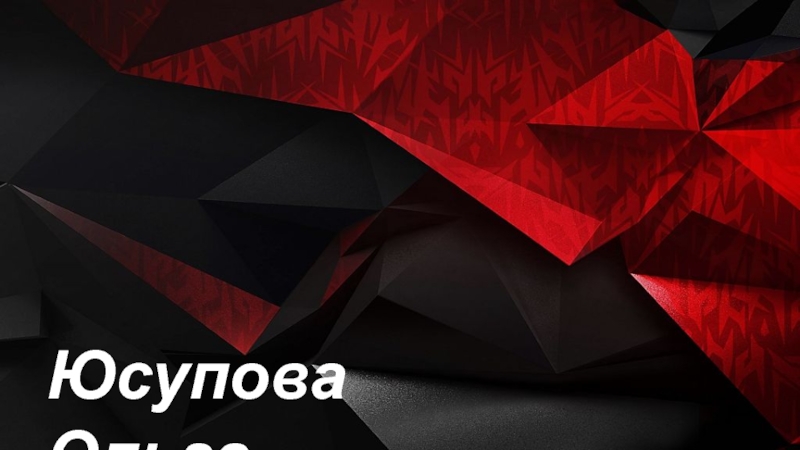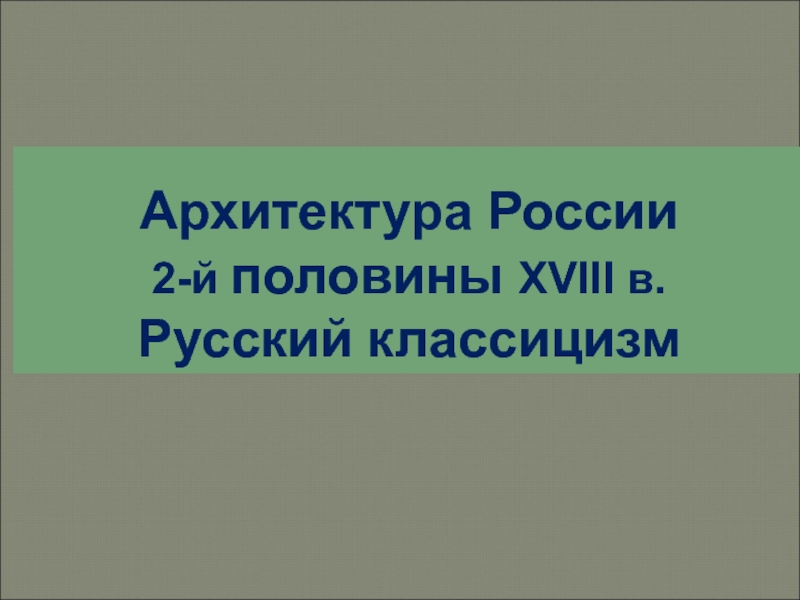Разделы презентаций
- Разное
- Английский язык
- Астрономия
- Алгебра
- Биология
- География
- Геометрия
- Детские презентации
- Информатика
- История
- Литература
- Математика
- Медицина
- Менеджмент
- Музыка
- МХК
- Немецкий язык
- ОБЖ
- Обществознание
- Окружающий мир
- Педагогика
- Русский язык
- Технология
- Физика
- Философия
- Химия
- Шаблоны, картинки для презентаций
- Экология
- Экономика
- Юриспруденция
World Tourism Market Defining and understanding the world tourism market Henryk
Содержание
- 1. World Tourism Market Defining and understanding the world tourism market Henryk
- 2. Statistical understanding of tourism: supply meaning offer
- 3. Tourism supplyTSA definitions and categories relating to
- 4. The nature of tourism supplyTourism supply is
- 5. What is TSA:RMF? Tourism Satellite Account:
- 6. What is TSA:RMF (for) ? (2)(2) to
- 7. TSA aggregates?Main aggregatesInternal tourism consumption in cashInternal
- 8. The supply side by TSATSA pursues “credibility
- 9. The supply side by TSA (2)The tourism
- 10. The supply side by TSA (3)Out of
- 11. Breakdown of tourism-specific products Tourism characteristic productsto
- 12. TSA 2008 classification of tourism products A. Consumption
- 13. TSA 2008 tourism industriesAccommodation for visitors 1.a. Accommodation
- 14. Characteristic tourism products left out from TSA
- 15. 2008: IMF takes TSA on boardThe United
- 16. World Travel and Tourism Council (WTTC) adopted
- 17. Indirect relationship of GATS with TSAThrough GATS
- 18. Observations to TSA 2008Under TSA, the term
- 19. Observations to TSA 2008 (2)TSA 2008 considers
- 20. Some TSA findingsThe bigger and the more
- 21. Consequences of TSA approachImportant for lobbying purposesThe
- 22. TSA outcomes and peculiarities TSA is believed
- 23. Other TSA shortcomingsSole emphasis is placed on
- 24. US Travel and Tourism Satellite Account Scope
- 25. Tourism supply defined in EU documents: Regulation
- 26. Definition of services by Directive 2006/123 on
- 27. (Tourism) services covered by EU Directive on
- 28. (Tourism) services covered by EU Directive on
- 29. (Tourism) services not covered by 2006/123 (Article
- 30. Relationship to GATS“This Directive concerns only providers
- 31. Tourism and travel related services in the
- 32. Some peculiarities and inconsistencies Relation to TSA,
- 33. Some peculiarities and inconsistencies Relation to TSA,
- 34. Tourism product as a “package” by EU
- 35. End of Part III
- 36. Слайд 36
- 37. …and further in PolandTourist services under the
- 38. Tourism product by the tourism sectorA “tourism
- 39. Summary – two types of tourism productsBy
- 40. Application of trade in goods to leisure
- 41. End part IIExplanation of conceptsSupply responding to demand
- 42. Скачать презентанцию
Слайды и текст этой презентации
Слайд 2Statistical understanding of tourism: supply meaning offer
From the supply
side, tourism is brought down to the production and supply
of all types of products (goods, services), including, in the first place, “tourism characteristic products”, to satisfy the needs of those on the move (travellers). The producers and suppliers can be (or are) both the private enterprise and the public sectorTourism characteristic products, in the statistical sense (TSA), are those whose output would be unnecessary or significantly reduced in the absence of demand from potential and active travellers)
Слайд 3Tourism supply
TSA definitions and categories relating to tourism supply
Relation to
WTTC, IMF
Tourism products versus services as defined by TSA
Tourism and
travel related services as defined by WTO (GATS)EU definitions of tourism supply, services, provider, recipient
National practice (Poland)
EU definitions of tourism products as packages
Tourism product defined by the tourism sector
Слайд 4The nature of tourism supply
Tourism supply is understood as the
direct provision to visitors of the goods and services that
make up tourism expenditureThe analysis of tourism supply consists, first, in showing how the conditions are created that enable producers to provide goods and services to visitors, and, second, in describing the processes, the production costs and the economic performance of the suppliers in the tourism industries
Слайд 5What is TSA:RMF?
Tourism Satellite Account:
Recommended Methodological Framework
A common national
accounts methodology agreed upon by the secretariats of (UN)WTO, OECD
and Eurostat (European Commission) with the Statistical Commission and the Statistics Division of the United Nations, each seeking to „measure tourism economic impacts”, in particular:(1) „to provide detailed and analytical imformation on all aspects of tourism” (to include):
The composition of tourism consumption
The productive activities most concerned by the activities of visitors (and)
Relationships with other productive activities
Слайд 6What is TSA:RMF (for) ? (2)
(2) to measure the quantative
importance of tourism in the country of reference by means
of „aggregates”Main aggregates
Other aggregates
Aggregates are believed “to have an important political impact because they measure the quantitative importance of tourism in the country of reference. This impact cannot be disregarded.”
Sources:
TSA:RMF. Commission of the European Communities, OECD, World Tourism Organization, United Nations Statistics Division; Luxembourg, Madrid, New York, Paris 2001, ISBN 92-844-0437-1, 2001
Positioning Tourism in Economic Policy: Evidence and Some Proposals; 2nd T.20 Ministers Meeting, Republic of Korea, 11-13 October 2010, UNWTO Statistics and Tourism Satellite Account Programme
Слайд 7TSA aggregates?
Main aggregates
Internal tourism consumption in cash
Internal tourism consumption (in
cash and kind)
Value added of the tourism industries
Tourism value added
Tourism
GDPOther aggregates
Tourism employment
Tourism gross fixed capital formation
Tourism collective consumption
Total tourism demand
Слайд 8The supply side by TSA
TSA pursues “credibility in the measurement
of tourism’s contribution from the supply side of the economy,
i.e. from the perspective of industries”, whereby:“In the traditional sense” industries are classified according to what they produce
Tourism is defined by the demand for products coming from a special type of consumer, the visitor
Слайд 9The supply side by TSA (2)
The tourism sector is the
cluster of production units in different industries, whereas:
The SNA 1993
(system of national accounts) defines an industry as “a group of establishments engaged in the same kind of productive activities”The System of National Accounts, 1993 (SNA93) was produced jointly by the OECD, the United Nations Statistical Division, the International Monetary Fund, the World Bank and the Commission of the European Communities
Слайд 10The supply side by TSA (3)
Out of all goods and
services (products), one can identify:
Tourism-specific products (170)
Products whose supply would
cease to exist in meaningful quantity in the absence of visitorsProducts that represent a significant share of tourism consumption
Products whose absence might significantly affect tourism consumption
Слайд 11Breakdown of tourism-specific products
Tourism characteristic products
to be commonly identified
everywhere, in all countries (e.g. hotel services)
Tourism-connected products
residual, not
to be found everywhere (e.g. specific adventure tourism services)Each type of service (as a product) is recognized in the Central Product Classification (CPC/Code), the International Standard Industrial Classification of All Economic Activities (ISIC) and the Standard International Classification of Tourism Activities (SICTA)
Слайд 12TSA 2008 classification of tourism products
A. Consumption products
A.1. Tourism characteristic
products
1. Accommodation services for visitors
1.a. Accommodation services for visitors other
than 1.b1.b. Accommodation services associated with all types of vacation home ownership
2. Food-and beverage-serving services
3. Railway passenger transport services
4. Road passenger transport services
5. Water passenger transport services
6. Air passenger transport services
7. Transport equipment rental services
8. Travel agencies and other reservation services
9. Cultural services
10. Sports and recreational services
11. Country-specific tourism characteristic goods
12. Country-specific tourism characteristic services
A.2 Tourism connected products
A.3. Non-tourism related consumption products
B. Non-consumption products
B.1. Valuables
B.2. Other non-consumption products
Слайд 13TSA 2008 tourism industries
Accommodation for visitors
1.a. Accommodation for visitors other
than 1.b
1.b. Accommodation associated with all
types of vacation home ownership2. Food-and beverage-serving industry
3. Railway passenger transport
4. Road passenger transport
5. Water passenger transport
6. Air passenger transport
7. Transport equipment rental
8. Travel agencies and other reservation services industry
9. Cultural industry
10. Sports and recreational industry
11. Retail trade of country-specific tourism characteristic goods
12. Other country-specific tourism characteristic industries
Слайд 14Characteristic tourism products left out from TSA 2008 product classification
Cruise
services
MICE
Transport supporting services
Parking
transport equipment
transport maintenance and repair
Tourist guide services
Other
guide than “tourist guide” (mountain, hunting, etc)Trade fair and exibition services
Fishing, hunting licence
Travel insurance services
Слайд 152008: IMF takes TSA on board
The United Nations and the
International Monetary Fund (IMF) identify tourism as a specific area
of economic activity and point to the Tourism Satellite Account as the appropriate tool for deriving key aggregates and internationally comparable indicators on the macroeconomic contribution of the sector worldwide.Sources: UN System of National Accounts 2008 (SNA, 2008); IMF’s Balance of Payments and International Investment Position Manual, Sixth Edition (BPM6)
Слайд 16World Travel and Tourism Council (WTTC) adopted its own tourism satellite
account
(from Oxford Economics)
A demand –side approach with a comprehensive
definition of its scope, linked by economic models to supply-side conceptsRelies heavily on economic modelling techniques
Provides largely bigger figures than than those by UNWTO’s TSA Tourism Satellite
Accounting methodology (TSA:RMF 2008) quantifies only the direct contribution of Travel & Tourism. But WTTC recognises that Travel & Tourism's total contribution is much greater, and aims to capture its indirect and induced impacts through its annual research…
Source: WTTC 2011 World Economic Impact Report
Слайд 17Indirect relationship of GATS with TSA
Through GATS (The General Agreement
on Trade in Services), WTO looks also into the trade
in tourism services (document W/120)Sector 9: Tourism and Travel Related Services
Hotels and restaurants (12 elements)
Travel agencies and tour operator services (2)
Tourist guides services (1)
Other
These are not all possible “Tourism and Travel Related Services” at all
A number of genuine tourism-related services according to TSA and EU have been left behind and attributed to other sectors (the “other” category is not supposed to refer to them)
Слайд 18Observations to TSA 2008
Under TSA, the term “product” equals service
which is understood as an economic outcome or output of
a specific (industrial, productive) activityTSA 2008 appears less specific than TSA 2000 with respect to tourism services (or products), but more specific with respect to concepts (e.g. travel agencies/tour operators are now regarded as reservation systems)
Слайд 19Observations to TSA 2008 (2)
TSA 2008 considers meetings, conferences and
conventions as activities “of any business, in any sector of
the economy” and that “its characteristic output is not mostly consumed by visitors, but by their conveners”, therefore, “this strong connection with tourism does not imply that the meetings industry qualifies as a tourism industry”The TSA term of tourism product is different from the legal, travel industry and marketing term of a tourism product (or package)
Слайд 20Some TSA findings
The bigger and the more varied an economy,
the smaller contribution of tourism to GDP (e.g. Canada, Germany,
Japan, USA)Tourism’s higher contribution in countries combining a relative high prosperity (consumption) level (even under the crisis) and natural holiday assets close to source markets (France, Italy, Spain). This is largely due to simultaneous domestic tourism consumption.
Higher contribution of international visitor consumption in comparison to other export categories in some developing countries/LDCs: because of otherwise limited (undeveloped) economy in other areas (the Caribbean, Egypt, Morocco, Maldives…)
This possibly limits their economic development possibilities in other productive areas (the case of small islands)
Слайд 21Consequences of TSA approach
Important for lobbying purposes
The self-proclaimed largest service
industry in the world
a mantra repeated to closed circuits and
audiencestourism is by far the most lobbied sector
Belief that “more tourism” (number of consumers, income, value added, “tourism GDP”, jobs) should automatically give rise to a better economy and a better life at destinations, in particular thanks to spillover (multiplying effects) or tourism consumption-driven production in a large number of (other) sectors
It is therefore argued (UNWTO Statistics) that accurate TSA (the more accurate and the more internationally comparable data, the better) may or even must give rise to tourism policies (objective largely not fulfilled)
Слайд 22TSA outcomes and peculiarities
TSA is believed to have become
a required modern standard in national statistics accounts
TSA calculations (by
central statistical bureaus) are already in place or under implementation in some 60 countriesUSA updates its TSA data every 3 months
UNWTO has committed to publish its TSA world figures every 3 years (which it doesn’t…)
but
The public at large, media and politicians do not know about the TSA „recommended framework”
They continue to consider tourism, as always, as travel at leisure for recreation and holidays (sightseeing, excursions)
“a tourism destination” is normally considered to denote a place where to go on holidays
Слайд 23Other TSA shortcomings
Sole emphasis is placed on economic and monetary
aspects, not really „all aspects”
TSA approach does not readily (automatically)
translate into the concept of „tourism services”Social, qualitative and cultural aspects are disregarded (e.g. access to paid holidays, tourism income (re) distribution, quality of life at destinations, governance aspects)
TSA does not analyze the loss of demand for locally available and unused supply of consumer products - due to consumer externalization (lost consumers) - in „the usual environment”
TSA data are notoriously not used to compare with other productive sectors or industries
Слайд 24US Travel and Tourism Satellite Account Scope and terminology (elements subject
to analysis): international comparability at risk
Traveler accomodations
Transportation
Passenger air transportation
All other
transportation-relatedFood services and drinking places
Recreation, entertainment and shopping
Recreation and entertainment
Shopping
Слайд 25Tourism supply defined in EU documents: Regulation (EU) No 692/2011 on statistics
(binding for central statistical offices)
Tourism supply is defined as
„tourism industry”Tourism industry is brought down (in statistics) just to „tourist accommodation establishments” including:
— hotels and similar accommodation,
— holidays and other short-stay accommodation,
— camping grounds, recreational vehicle parks and trailer
parks
Supply (tourist accommodation establishments) is expressed in terms of:
Number of establishments
Capacity (number of bed places and bedrooms)
Слайд 26Definition of services by Directive 2006/123 on services in the
internal market (free circulation of services)
(Article 4)
1) ‘service’ means any
self-employed economic activity, normally provided for remuneration.2) ‘provider’ means any natural person who is a national of a Member State, or any legal person ….established in a Member State, who offers or provides a service;
- WTO (trade) refers to the term “supplier” and defines “supply
of a service” (production, distribution, marketing, sale,
delivery)
3) ‘recipient’ means any natural person who is a national of a Member State or who benefits from rights conferred upon him by Community acts, or any legal person …established in a Member State, who, for professional or non-professional purposes, uses, or wishes to use, a service;
Слайд 27(Tourism) services covered by EU Directive on services in the
internal market (2006/123) -1
(33) The services covered by this Directive
concern a wide variety of ever-changing activities, including business services such as management consultancy, certification and testing;facilities management, including office maintenance;
advertising; recruitment services; and the services of commercial agents. The services covered are also services provided both to businesses and to consumers, such as legal or fiscal advice; real estate services such as estate agencies; construction, including the services of architects; distributive trades; the organisation of trade fairs;
car rental; (and)
travel agencies.
Слайд 28(Tourism) services covered by EU Directive on services in the
internal market (2006/123) - 2
Consumer services are also covered, such
as those in the field of tourism, including tour guides;leisure services, sports centres and amusement parks;
and, to the extent that they are not excluded from the scope of application of the Directive, household support services, such as help for the elderly.
Those activities may involve services requiring the proximity of provider and recipient, services requiring travel by the recipient or the provider
and services which may be provided at a distance, including via the Internet
Слайд 29(Tourism) services not covered by 2006/123
(Article 2)
This Directive shall not
apply to:
services in the field of transport, including port services,...;
financial
services, such as banking, credit, insurance and re-insurance.;healthcare services; whether or not they are provided via healthcare facilities, and regardless of the ways in which they are organised and financed at national level or whether they are public or private;
gambling activities which involve wagering a stake with pecuniary value in games of chance, including lotteries, gambling in casinos…;
private security services;
Слайд 30Relationship to GATS
“This Directive concerns only providers established in a
Member State and does not cover external aspects”.
“It does
not concern negotiations within international organisations on trade in services, in particular in the framework of the General Agreement on Trade in Services (GATS)”Слайд 31Tourism and travel related services in the General Agreement on
Trade in Services (GATS)
Services are not defined per se but,
as in the case of the EU (Directive 2006/123), are identified by the scope of the agreement application and specifically enumerated (document W/120)The term “Services”, therefore, “includes any service in any sector except services supplied in the exercise of government authority” (Article 1: Scope and Definition)
Like in the case of TSA, each listed service activity has a CPC (central product classification) number, e.g. 7174 (travel agencies and tour operator services)
WTO takes (publishes) data on trade in tourism services taken from the IMF statistics
Слайд 32Some peculiarities and inconsistencies Relation to TSA, statistics regulation (692/2011) and
travel package directive
Specific categories of services are not identified with
CPC numbersBusiness services partly refer to inputs to (tourism) industries and/or tourism products (also understood as such by the tourism sector), partly to stand-alone services made available to final tourism consumers )
The definition of “consumer services in the field of tourism” excludes a number of genuine tourism services; the services directive is not compatible with tourism statistics regulation (and vice versa)
Слайд 33Some peculiarities and inconsistencies Relation to TSA, statistics regulation (692/2011) and
travel package directive
Healthcare services are excluded but nevertheless are part
of “health tourism” (or “medical tourism”)Travel agencies services are shown separately from “consumer services in the field of tourism” (such as tour guides) or “leisure services”
Terminology and content excluding transport services was not consistent with travel package directive 90/314 (which did address transport and health)
Note: this directive, however, was enacted under the category of consumer protection, not “tourism”
Слайд 34Tourism product as a “package” by EU
A ready-made package
of services, as defined by (EU) 90/314 Council Directive 90/314/EEC
of 13 June 1990 on package travel, package holidays and package tours, consisting of a few interrelated services needed for a trip or stay at a destination. Its territorial coverage can be variable, from focalized (e g cruise) to broad (city, region, country)1. 'package' means the pre-arranged combination of not fewer than two of the following when sold or offered for sale at an inclusive price and when the service covers a period of more than twenty-four hours or includes overnight accommodation:
(a) transport;
(b) accommodation;
(c) other tourist services not ancillary to transport or accommodation and accounting for a significant proportion of the package.
Слайд 37…and further in Poland
Tourist services under the Polish Classification of
(Economic) Activities (Polska Klasyfikacja Działalności)
Activity of tourist agents (79.11.A)
Activity of
tourist intermediaries (79.11.B)Activity of tourism organizers (79.11.Z)
Rozporządzenie Rady Ministrów z dnia 24.12.2007 r. w sprawie Polskiej Klasyfikacji Działalności (PKD)
Слайд 38Tourism product by the tourism sector
A “tourism product” represents a
combination of different aspects (characteristics of the places visited, modes
of transport, types of accommodation, specific activities at destination, etc.) around a specific centre of interest, such as nature tours, life on farms, visits to historical and cultural sites, visits to a particular city, the practice of specific sports, the beach, etc.The notion of “tourism product” is not related to the concept of “product” used in economic statistics, but rather used by professionals in the tourism business to market specific packages or destinations
It is then possible to speak of specific types of “tourism products”, such as culinary tourism, ecotourism, sun-and-sand tourism, agro-tourism, health tourism, winter tourism, etc.
Source (quatations): United Nations, International Recommendations for Tourism Statistics 2008
Слайд 39Summary – two types of tourism products
By TSA and the
like,derived from services
Where “tourism products” are represented by industries which
are the means for attaining a tourism product as understood by (tourism) industryThese, in general, are independent of travel motivations (“centres of interest”), but their required type, content or level (choice) do depend on travel motivations as well as on the relative propensity to travel (economic, cultural, demographic)
By travel (tourism) organizers, whether professional or individuals themselves (self-organizers), also “DMOs” („destination marketing organizations”), whereby amounting to:
“combination of different aspects” and inputs
“around a specific centre of interest”
also depending on the relative propensity to travel (income, social origin, age)
